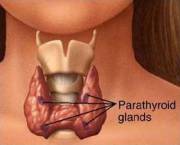 56 year old Hispanic female with a history of hypertension, type 2 diabetes on oral medications, hyperlipidemia and normal renal function. Over the past 2 years she has been noted to have mild hypercalcemia (11.0-11.5) on several basic metabolic panels. On her last visit, intact PTH was checked and was elevated at 66 (normal range 7-57). In patients such as this, with apparent asymptomatic primary hyperparathyroidism, what further diagnostic tests should be done and in whom is surgery indicated?
56 year old Hispanic female with a history of hypertension, type 2 diabetes on oral medications, hyperlipidemia and normal renal function. Over the past 2 years she has been noted to have mild hypercalcemia (11.0-11.5) on several basic metabolic panels. On her last visit, intact PTH was checked and was elevated at 66 (normal range 7-57). In patients such as this, with apparent asymptomatic primary hyperparathyroidism, what further diagnostic tests should be done and in whom is surgery indicated?
-Danise Schiliro, MD PGY-3
What is the most likely diagnosis? The diagnosis of primary hyperparathyroidism (PHPT) is quite likely in this patient based on the presence of hypercalcemia (of relatively long duration) in the face of an inappropriately elevated intact parathyroid hormone (iPTH) level. Because interventions differ based on etiology, it is important to recognize that PHPT is caused by a single adenoma in ~ 80% of cases, and by hyperplasia of all 4 glands in most of the remaining patients. Hyperplasia may occur sporadically, but it may also occur in association with multiple endocrine neoplasia type 1 or type 2A, so these should be considered (can usually be done with thorough history and physical). There are also several (rare) forms of familial hyperparathyroidism (not associated with MEN). Parathyroid carcinoma is an exceedingly uncommon cause of PHPT, but should also be at least briefly considered (and then usually quickly forgotten!).
Several medications may serve stimulate parathyroid hormone secretion. Lithium is one culprit, but most notorious is HCTZ. If your patient is taking HCTZ, (and the hypercalcemia is mild), d/c the HCTZ, and recheck Calcium and iPTH in a few weeks. It is also important to r/o familial hypocalciuric hypocalcemia (FHH), a mutation of the calcium-sensing receptor. FHH (in which a modestly elevated PTH may be seen) can be distinguished from PHPT by positive FHx, usual onset in adolescence or young adulthood, and by a urinary Ca to urinary Cr ratio < 0.01. Tertiary HPTH, seen in association with ESRD will be obvious.
Evaluation of patients with asymptomatic PHPT should include the following:
- 24 hour urine for calcium and creatinine (already done to ddx FHH)
- bone density measure (3 –site, i.e., hip, lumbar spine, and distal radius)
- Vitamin D studies (25 hydroxyVit D & 1,25 dihydroxyVitD – some might not get these)
Which patients with PHPT should be referred for surgery?
- Patients with serum calcium > 1 mg/dl above the upper limit of normal for lab
- Patients with urinary calcium excretion > 400 mg per day
- Patients with T score < – 2.5 at hip, lumbar spine, or radius
- Patients with h/o nephrolithiasis
- Patients with creatinine clearance 30% lower than age matched normals
- Age < 50
What is the natural history of asymptomatic PHPT in patients who do not meet criteria and do no undergo surgery?
- Average serum calcium is stable over 10 years
- Average PTH is stable over 10 years
- Average bone mass as measured by DEXA is stable
- In general, hypercalciuria does not progress
- *25% of patients will progress (only age appears to predict progressors, with those < 50 being ~ 3 times more likely to progress)
What else should be considered prior to surgery, if you and patient decide to go that route?
Localization procedures – to quote Dr. Bilezikian, “the best localization procedure is localizing a good surgeon”. That said, most surgeons will want a sestamibi scan (details beyond the scope of this discussion).
What type of surgical procedure is appropriate – Sorry folks, also beyond the scope of this quick discussion. This is an area of active discussion among endocrinologists and surgeons.All patients referred for “minimally invasive” parathyroid surgery should have pre-op localization/imaging done. In general, I encourage people to save their health care dollars and NOT to obtain a localization procedure unless the patient is going for surgery.
What is appropriate f/u for patients with PHPH who do not undergo surgery?
- Measure serum calcium every 6 months
- Measure serum creatinine annually
- Measure (3-site) bone density annually
- Patients should be maintained on age appropriate dietary calcium
- 400 IU dietary Vitamin D per day is appropriate for most patients with PHPT
What are possible medical therapies for people refusing/not good surgical candidates?
- Bisphosphonates
- Estrogen therapy (with obvious concerns)
- SERMS
- Calcimimetics (such as cinacalcet)
What about the patient in question? For the patient in question, I would check if she is on HCTZ (and stop it and recheck her calcium if she is). I would consider her glycemic control, her renal function, and her co-morbidities. Because of her (relatively) young age, and the potential nephrotoxicity if her dm is poorly controlled), if she does not have significant co-morbidities that might impact her life-expectancy, I would be inclined to operate sooner rather than later if she came close but did not quite meet criteria for surgery.
